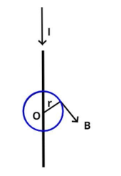
State Ampere’s circuital law.
Answer
434.4k+ views
Hint: In this question consider a straight current carrying wire since current is simply flow of electrons and this flow of electrons give rise to a magnetic field thus magnetic fields and also consider an imaginary loop around this conductor as shown also known as imperial loop of radius r, so write the magnetic field at any point on this loop. This will help approaching the problem.
Step By Step Answer:
Ampere’s Circuital law:
It is the relationship between the current and the magnetic field created by the current.
So according to this law the integral of magnetic field density (B) along an imaginary path is equal to the product of the permeability of the free space and the current enclosed by the path.

Let us consider an electrical conductor which carries current I in the downward direction as shown in the figure, we also consider an imaginary loop around this conductor as shown also known as amperian loop, so due to this the magnetic field at any point on this loop is given as,
Where,
This law is the basis of the Biot – savart law
Biot – savart law –
The Biot-Savart Law is an equation that describes the magnetic field created by a current-carrying wire and allows you to calculate its strength at various points.
Biot Savart Law
Note: The same role ampere’s circuital law plays in magnetic physics the same is played by Gauss Law in electrostatic physics. The common thing about Gauss law and ampere circuital law is that both are applied to the systems in which the current flowing has symmetrical distribution.
Step By Step Answer:
Ampere’s Circuital law:
It is the relationship between the current and the magnetic field created by the current.
So according to this law the integral of magnetic field density (B) along an imaginary path is equal to the product of the permeability of the free space and the current enclosed by the path.

Let us consider an electrical conductor which carries current I in the downward direction as shown in the figure, we also consider an imaginary loop around this conductor as shown also known as amperian loop, so due to this the magnetic field at any point on this loop is given as,
Where,
This law is the basis of the Biot – savart law
Biot – savart law –
The Biot-Savart Law is an equation that describes the magnetic field created by a current-carrying wire and allows you to calculate its strength at various points.
Biot Savart Law
Note: The same role ampere’s circuital law plays in magnetic physics the same is played by Gauss Law in electrostatic physics. The common thing about Gauss law and ampere circuital law is that both are applied to the systems in which the current flowing has symmetrical distribution.
Recently Updated Pages
Master Class 4 Maths: Engaging Questions & Answers for Success

Master Class 4 English: Engaging Questions & Answers for Success

Master Class 4 Science: Engaging Questions & Answers for Success

Class 4 Question and Answer - Your Ultimate Solutions Guide

Master Class 11 Economics: Engaging Questions & Answers for Success

Master Class 11 Business Studies: Engaging Questions & Answers for Success

Trending doubts
What is the difference between resemblance and sem class 12 social science CBSE

What is the Full Form of PVC, PET, HDPE, LDPE, PP and PS ?

Draw ray diagrams each showing i myopic eye and ii class 12 physics CBSE

Why do the transition elements have higher enthalpies class 12 chemistry CBSE

What are the advantages of parallel combination over class 12 physics CBSE

What are the causes of overloading class 12 physics CBSE




